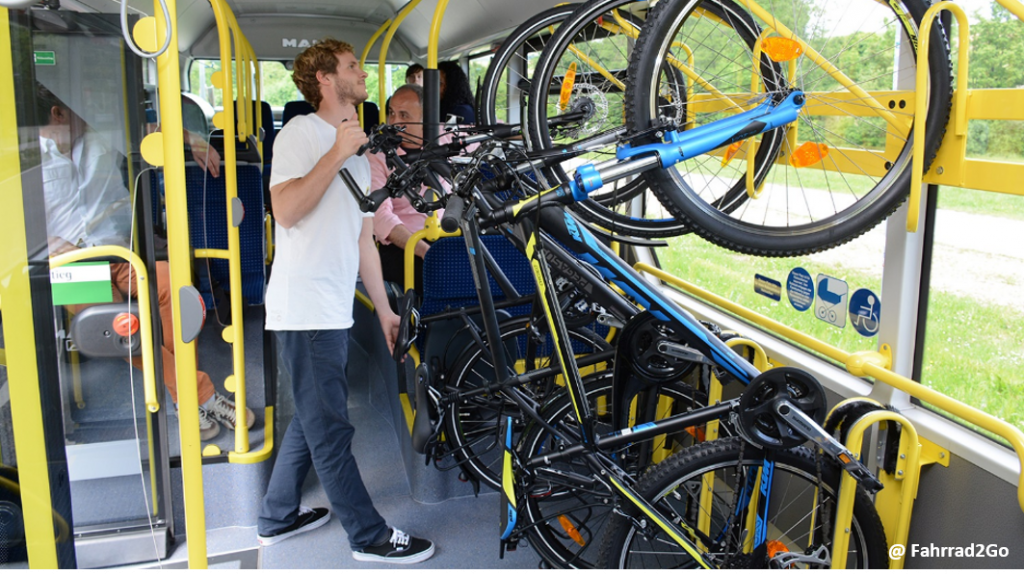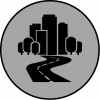
1. Presentation
Supplying a travel option that allows the integration of the bicycle in public transport, in such a way that the use of both is fostered.
2. Objectives
- Supplying a travel options that supports the increase in the number of both public transportation and bicycle users, thus contributing to reach several environmental, energy saving and traffic mitigation benefits;
- Increasing mobility options;
- Increasing accessibility;
- Increasing the catchment area of bicycle and public transport;
- Bicycle promotion.
3. Measure´s importance
Public transportation is more effective for medium to long distance trips in busy streets, while cycling is more effective in less distant trips, with several stops. The combination of both can create a high level of mobility, capable of competing with car tips.
1. Best Practices
– Users should be involved in the programme planning and in the selection of integrated bicycle and public transportation solutions.
– Bicycle parking should be well designed, installed away from circulation areas and provide weather protection. If possible, sealed bicycle storage should be available, appropriate for long periods of time (see Bike Parking Network).
– Ideally, the programme should include the provision of Bike sharing systems (see Bike sharing systems).
– The programme should be well divulged and include instructions on how to use the facilities.
– Monitor citizens’ adaptation to changes and reformulate measures to respond to users’ needs, without compromising sustainable ideals (See Management, monitoring and maintenance).
– Explain the principles behind the measures taken so that their need and functioning are clear (See Information).
2. Actions
| Outside transportation | |
 | Bus front-end bicycle racks A solution for bicycle transportation on bus is the installation of bicycle racks on the outside of the vehicle. These racks can be mounted on the front or back-end and they normally have the capacity for 2 or 3 bicycles. Advantages: Economic solution that offers good visibility and enables the driver to control the amount of users. Quick to load and unload (short stops). No negative impact n passenger capacity. Disadvantages: Limited capacity. Implications on pedestrian safety. Not allowed in some EU countries. |
 | Bus back-end bicycle racks Advantages: If necessary, the rack can easily be moved to the side to allow access to the engine. Does not block the motorist sight. Does not block the vehicle lights. Disadvantages: Limited capacity. Demands more time to load and unload the bicycles The activity can’t be monitored by the driver. |
 | Bus with bicycle trailer The bicycle trailers are linked to the back-end of buses. There are many types, sizes and solutions. Normally, a trailer can transport up to 20 bicycles. Advantages: No negative impact on passenger capacity. Disadvantages: Demands ample and safe loading and unloading space and time. The activity has to be done by a professional. The total size of the bus with the trailer complicates manoeuvres in urban context. |
| Inside transportation | |
 | Shared space All measures that allow bicycle transportation inside public transportation demand some form of space distribution. The simplest way is to create more free space for multiple users (standing passengers, bicycles, baby strollers and wheelchairs). Advantages: Permanent bicycle vigilance from the cyclist. Disadvantages: In case of a high demand (peak time) or competing space with a disabled passenger, cyclists must leave the vehicle or find another available space. |
 | Standing transportation The bicycle driver must stand to secure its bicycle, usually in a predefined space. It is recommended to establish the number of permitted bicycles. Advantages: Permanent bicycle vigilance from the cyclist. Disadvantages: Usually, the bicycle is only permitted near the vehicle entrances, but it should not block them. Due to the risk of emergency breaks, the cyclist must be close to a pole or other secure device to avoid falling. |
 | Hanging racks Advantages: The bicycle is secured in a space segregated from the passengers. Disadvantages: Implementation costs. Not unsuitable for places with a low cyclists’ presence. |
 | Mixed area Advantages: Folding seats allow the passengers to be comfortable when quantity of bicycles is low. Disadvantages: The solution is more appropriate for off-peak times, when there isn’t a high demand for public transportation. |
| Accessibility | |
 | Infrastructure Bicycle access to public transportation can be improved through the implementation of cycle paths and improvements in the streets that facilitate access to stations and terminals (Cycle paths connecting to parking spaces; Cycle paths connecting to neighbouring communities through the shortest and most direct path – See Cycling network). Advantages : Promotes bicycle and public transportation use. Widens he catchment area, that is, the influence area of each public transportation stop. Disadvantages: Implementation cost. |
 | Bicycle stair ramp If bicycles are permitted in the train and subway, access to the platforms is of extreme importance to the user’s comfort. An economic solution is of constructing rails where bicycles can be pushed alongside the stairs until the platforms. Advantages: Comfort when using bicycles in transport stations. |
 | Signs and information Clear and visible signing in the places where bicycle transportation is allowed. Signs, information and maps identifying routes and parking places in the stations and common destinations. Advantages: Comfort and incentive to bicycle use. |
 | Bike sharing systems Bike sharing is a bicycle rental system designed to supply efficient mobility for short and utilitarian urban trips. These systems often have bicycle stations on public transportation stops and stations (See Bike sharing systems). |
 | Bike parking network Install bike parking infrastructure near public transport stops and stations, to facilitate the use of the bicycle to complement the routes. (See Bike parking network) |
 | Connecting people and public transport (See Connecting people and public transport). |
1. Impacts
 | Mobility system efficiency The possibility of transporting bicycles on buses, trains and other public transportations increases their catchment area, contributing to the reduction of traffic congestion and an increase in efficiency in the mobility system. |
 | Livable streets Is recognized that opting for cycling and public transports over private car trips improves living standards in neighbourhoods and communities. |
 | Protection of the environment Using public transportation and bicycles has the recognized benefit of emitting less atmospheric pollutants than automobiles. |
 | Inclusion, equity and accessibility Some lower income groups can benefit from the improved low cost transportation option provided by integrating bicycles and public transports. |
 | Safety and comfort Installing bicycle storage lockers and implementing cycle paths connecting to public transportation terminals may improve the safety and comfort perception. |
 | Economic value By acting as a complement to public transportation, bicycles are presented as a solution to the last mile problem, increasing the competiveness of public transportation by extending the catchment area and thus potentially avoiding additional investments in more expensive public transportation services. |
 | Awareness and acceptability Since the bicycle is a short distance transportation mode, modal integration increases cyclists’ destination options. Therefore, its integration with public transportation causes cyclists to have a greater ease at reaching their destinations (work commutes, recreation trips, etc.). This improvement in accessibility has the potential of increasing the number of cyclists and contributing to the normalization of the bicycle has a means of urban transportation. |
Legend:
| Very positive | Positive | Neutral | Negative | Very negative |
2. Barriers
 | Legal The integration of bicycles in public transportation systems is, in some cases, regulated by local vehicle codes that might restrict integration or limit bicycle racks, when these alter the vehicle’s total length or width. |
 | Finance Despite the recognition given to bicycles as a means of transportation, generally, few resources are allocated to the bicycle, when compared to other initiatives in different transportation means. |
 | Governance The development and implementation of bicycle integration programmes requires the involvement of several departments, including planning, marketing, engineering, safety and maintenance. The necessary coordination of transport’s promotional actions with cyclists organizations, defence groups and local governments can contribute to the promotion of the topic and generate additional interest. |
 | Political acceptability Bicycle incentive measures frequently have less priority than the measures related with motorized vehicles, though it’s unlikely the measures is controversial. |
 | Public acceptability Several groups are expected to provide support, including public transportation users and pro-bicycle groups. However, there will also be those who oppose significant investments. |
 | Technical feasibility Some programmes create negative impacts in the speed of the operation, the reliability, safety, maintenance and cost, which are disproportionate to the benefits of those programmes. |
Legend:
| No barrier | Minimum barrier | Moderate barrier | Significant barrier |
3. Budget
| Area | Measure | Unit | Cost | Implementation year |
| Chicago, Illinois (E.U.A.) | Installation of bicycle racks | 4 bus routes | 2 500,00 $ | 2001 |
Case Study 1: Bike-Transit Integration in San Francisco (US)


San Francisco Bay Area has been a leader in bike-transit integration efforts in North America. The Bay Area Rapid Transit (BART) provides bicycle parking in almost all of its 43 stations, with a total of 4 313 bicycle spaces in 2009, including 1 010 safe bicycle lockers. To increase convenience and flexibility, BART has been introducing electronic bicycle lockers, which function on a “first come first served” basis and don’t require registration. Caltrain, San Francisco’s suburban railway line, offers bicycle parking in all of its 32 station, with a total of 1 100 bicycle lockers and 400 bicycle stands. Neither of them charges on-board bicycle transportation. In addition, main Caltrain trains offer special accommodation for 16 to 32 bicycles, depending on time period and destination. Complementing bicycle access to BART and Caltrain, practically all public transportation buses in the Bay Area are equipped free bicycle racks. Most ferries also allow bicycles on board without charging extra. The percentage of trips in public transportation more than tripled since 1990.
Impact:
 | Mobility system efficiency The percentage of public transportation trips combined with bicycles has more than tripled since 1990, which should have contributed to a substantial reduction if traffic congestion. |
 | Livable streets Is recognized that opting for cycling and public transports over private car trips improves living standards in neighbourhoods and communities. |
 | Protection of the environment The combined use of bicycles and public transportation is a popular option in San Francisco, which can contribute to a substantial reduction in air and noise pollution. |
 | Inclusion, equity and accessibility Neither BART or Caltrain charge bicycle transportation, thus all groups can benefit from a cheaper and more convenient travel mode. However, in the E.U.A., the persistent increase in imbalances between genders and races suggested more information on their causes and better policy conception are needed to push more women and minorities to cease the benefits of bicycle integration. |
 | Safety and comfort No data. |
 | Economic value No data. |
 | Awareness and acceptability No data. |
Case study 2: Different bicycle transportation options in Stuttgart (Germany)



The public transportation system in Stuttgart offers different options for bicycle transportation. The commonest way is the suburban train (S-Bahn), which are supplied by the regional transport organization. The transport is free of charge except in the period between 06:00 and 8:30, when the purchase of a ticket is required. There are special compartments with an open space to park and repair bicycles. The metro also allows bicycle transportation free of charge. Another option is the bicycle rack assembled in the city’s tram, used to cross steep slopes. In addition, there are support stations and bicycle parking in 6 interchange stations, where the passengers can store their bicycles and change to public transport. In August 2014, the innovative “Fahrrad2go” was implemented on a regional bus. The system offers a transportation option up to 10 bicycles, 5 in the inside and 5 on the outside platform.
Impact:
 | Mobility system efficiency A study indicates Stuttgart has a modal split of 5%. The fact they are investing in new projects, like “Fahrrad2go”, indicates that bicycle integration in public transport contributes to increase cycling levels. |
 | Livable streets Is recognized that opting for cycling and public transports over private car trips improves living standards in neighbourhoods and communities. |
 | Protection of the environment The “Fahrrad2go” project focused on creating a better connection between the different public transport systems to reduce CO2 emissions through the modal split from private car to public transportation. |
 | Inclusion, equity and accessibility The different bicycle transportation options are free of charge, except during peak times, hence, all groups can benefit cycling and public transportation as cheap transportation modes. |
 | Safety and comfort No data. |
 | Economic value No data. |
 | Awareness and acceptability No data. |
Case Study 3: Helping cyclists travel on public transport in Moravia (Czech Republic)
In April 2012, the public transport operator and Moravia’s local authorities launched a project to better integrate bicycles in public transport, associated to a sustainable tourism strategy. The buses were equipped with trailers and trains received a bicycle transportation compartment, allowing visitors to travel and pedal easily in one of Check Republic’s more sought after region.
Even though trains had already been offering bicycle transportation for some years, in 2012 new measures were introduced to widen the range of options of bicycle transportation. Buses from 12 routes were equipped with trailers (up to 20 bikes) available on weekends from the end of April to the end of September. On trains, bicycle compartments were widened has part of the wagon composition and 2 new connections adopted this option.
Impact:
 | Mobility system efficiency No data. |
 | Livable streets No data. |
 | Protection of the environment The combined use of bicycle and public transport facilitates the use of transports less polluting per people it carries. |
 | Inclusion, equity and accessibility No data. |
 | Safety and comfort The combined use of bicycle and public transportation makes the region more appealing for bicycle tourism as healthier and more sustainable recreation. |
 | Economic value Approximately 2 500 tourists per year use the buses to carry their bicycles, while more than 20 000 wash their bikes on trains. Even if ‘bicycle-train’ use is comparatively marginal, the systematic approach of introducing bicycle transport installations in both buses and trains has increased the number of cyclists that visit the region, without any rise in operational costs. This increase in visitors can have positive economic impacts in hotel businesses and local trading. |
 | Awareness and acceptability No data. |
Legend:
| Very positive | Positive | Neutral | Negative | Very negative |
Buehler, R., & Tech, V. (2009). Integrating Bicycling and Public Transport in North America. Journal of Public Transportation, 12(3), 79–104.
Cerny, J., & Daggers, T. (2016). Bicycles on Board: Integration of bicycle transport in Public Transport, a study in the framework of the 2MOVE2 CIVITAS. Accessed 2 July 2019. Available at: https://civitas.eu/sites/default/files/bikes_on_board_2move2_di7.02.03.pdf
Chicago Transit Authority (2000). 2001 annual budget department detail & 2001-2005 capital program. Accessed 2 July 2019. Available at: https://www.transitchicago.com/finance/
Kager, R., & Harms, L. (2017). Synergies from Improved Cycling-Transit Integration Towards an integrated urban mobility system Discussion Paper 2017-23 prepared for the Roundtable on Integrated and Sustainable Urban Transport 24-25 April 2017, Tokyo. Accessed 2 July 2019. Available at: https://www.itf-oecd.org/sites/default/files/docs/improved-cycling-transit-integration-synergies.pdf
Millar, W. W., Banks, S. D., Barnes, L. E. E., Blair, G. L., Bonsall, J. A., Draggoo, S., … Francois, F. B. (1994). Integration of Bicycles and Transit. Accessed 6 February 2019. Available at: http://onlinepubs.trb.org/onlinepubs/tcrp/tsyn04.pdf.
Urban Design Working Group. (2018). BICYCLE AND TRANSIT INTEGRATION: a practical transit agency guide to bicycle integration and equitable mobility. Accessed 2 July 2019. Available at: https://www.transproconsulting.com/pdf/APTA_Bicycle_&_Transit_Integration_FULL_GUIDE.pdf
VTPI. Victoria Transport Policy Institute (2016). Bike/Transit Integration. Online Transportation Demand Management (TDM) Encyclopedia. Accessed 2 July 2019. Available at: http://www.vtpi.org/tdm/tdm2.htm
